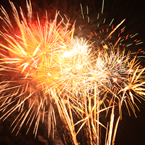Fireworks
Fireworks are a class of explosive
pyrotechnic devices used for aesthetic and entertainment
purposes. The most common use of a firework is as
part of a fireworks display. A fireworks event (also
called a fireworks show or pyrotechnics) is a display
of the effects produced by firework devices. Fireworks
competitions are also regularly held at a number
of places. Fireworks (devices) take many forms to
produce the four primary effects: noise, light,
smoke, and floating materials (confetti for example).
They may be designed to burn with flames and sparks
of many colors, typically red, orange, yellow, green,
blue, purple, and silver. Displays are common throughout
the world and are the focal point of many cultural
and religious celebrations.
The earliest documentation of fireworks dates back
to 7th century China, where they were invented.
The fireworks were used to accompany many festivities.
It is a part of the culture of China and had its
origin there, eventually it spread to other cultures
and societies. Important events and festivities
such as the Spring Festival (Chinese New Year) and
the Mid-Autumn Festival were and still are times
when fireworks are guaranteed sights. China is the
largest manufacturer and exporter of fireworks in
the world.
Fireworks date back to the 10th century and originated
in China. The Chinese developed many different kinds
of fireworks with a variety of effects and color.
The art and science of firework making developed
into an independent profession. In China, pyrotechnicians
were respected for their knowledge of complex techniques
in mounting firework displays.
During the Song Dynasty (960–1279), many of
the common people could purchase various kinds of
fireworks from market vendors, and grand displays
of fireworks were also known to be held. In 1110,
a large fireworks display in a martial demonstration
was held to entertain Emperor Huizong of Song (r.
1100–1125) and his court. A record from 1264
states that a rocket-propelled firework went off
near the Empress Dowager Gong Sheng and startled
her during a feast held in her honor by her son
Emperor Lizong of Song (r. 1224–1264). Rocket
propulsion was common in warfare, as evidenced by
the Huolongjing compiled by Liu Ji (1311–1375)
and Jiao Yu (fl. c. 1350–1412). In 1240 the
Arabs acquired knowledge of gunpowder and its uses
from China. A Syrian named Hasan al-Rammah wrote
of rockets, fireworks, and other incendiaries, using
terms that suggested he derived his knowledge from
Chinese sources, such as his references to fireworks
as "Chinese flowers".
Palm Fireworks
A shell containing a relatively few
large comet stars arranged in such a way as to burst
with large arms or tendrils, producing a palm tree-like
effect. Proper palm shells feature a thick rising
tail that displays as the shell ascends, thereby
simulating the tree trunk to further enhance the
"palm tree" effect. One might also see
a burst of color inside the palm burst (given by
a small insert shell) to simulate coconuts.
(Source: Wikipedia.org)
|
















